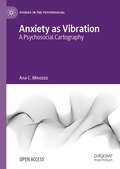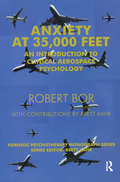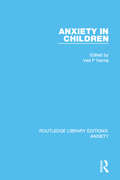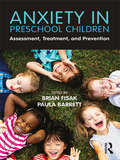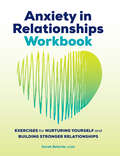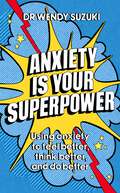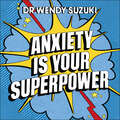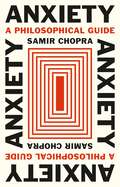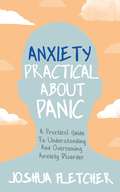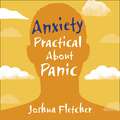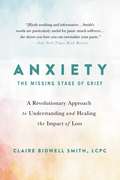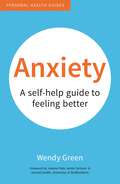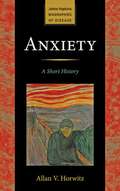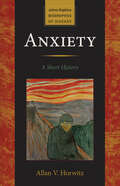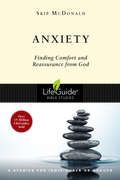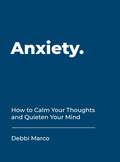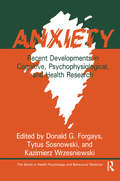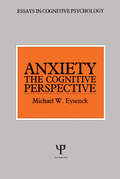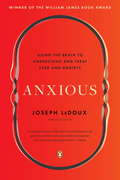- Table View
- List View
Anxiety as Symptom and Signal
by Steven P. Roose Robert A. GlickThe concept of anxiety has long held a central place in psychoanalytic theories of mind and treatment. Yet, in recent years, data from the neurosciences and from pharmacological studies have posed a compelling challenge to psychoanalytic models of anxiety. One major outcome of these studies is the realization that anxiety both organizes and disorganizes, that it can be both symptom and signal. In Anxiety as Symptom and Signal, editors Steven Roose and Robert Glick have brought together distinguished contributors to address these different dimensions of anxiety. A section of original papers on "Anxiety as Symptom" covers evolutionary, neuroanatomical, genetic, and developmental perspectives. A complementary section on "Anxiety as Signal" focuses on the meanings and functions of anxiety in the clinical process; contributions address anxiety in its ego-psychological, intersubjective, and relational dimensions. The illuminating, readable collection will broaden clinicians' awareness of the diverse research findings that now inform our understanding of anxiety. No less importantly, it will deepen their appreciation of the richly variegated ways that anxiety can shape, and be shaped by, the clinical process.
Anxiety as Vibration: A Psychosocial Cartography (Studies in the Psychosocial)
by Ana C. MinozzoThis open access book draws on the work of Deleuze and Guattari alongside Lacan and Freud to offer a radical psychosocial survey of the status of anxiety. Taking a multidisciplinary approach, the book examines key issues in contemporary diagnosis and points towards possibilities for forging a more creative clinic. Departing from a feminist, non-Oedipal positioning towards psychoanalytic texts, the author invites art theory, medical humanities and philosophy into a conversation that seeks to answer the question: What can anxiety do? Here, Ana Minozzo explores the possibilities of an encounter with the Real as a sphere of excessive affect in psychoanalysis, and terms this meeting a ‘vibration’. Situating this enquiry within the art practice of Lygia Clark, the book utilises vibration as a conceptual artifice when considering affects, their ethical horizons and a psychoanalytic possibility for creating new ways of living. This book offers exciting new perspective on anxiety for students, clinical trainees, art and humanities researchers and practitioners and those interested in psychoanalytic ideas in general.
Anxiety at 35,000 Feet: An Introduction to Clinical Aerospace Psychology (The Forensic Psychotherapy Monograph Series)
by Robert BorThis book covers the mental health and psychology of pilots, including the psychological requirements for certification, environmental challenges, psychological problems among air crew, the effects of disruption to personal relationships, alcohol and drug misuse, and pilot reactions to accidents.
Anxiety in Childhood and Adolescence: Encouraging Self-Help Through Relaxation Training (Routledge Library Editions: Anxiety #1)
by Frank Carter Peter CheesmanMany counter-productive behaviours in children may be anxiety-related and in this book, originally published in 1988, the authors proposed that a disabling level of tension and stress experienced by many children frequently goes unrecognised. This often leads to failure to analyse psychological and educational problems and inappropriate ways of dealing with them. This book was aimed at all professional staff working with children, particularly educational and clinical psychologists and teachers. The book is however written in a jargon-free manner and should have wide appeal. The authors show how tension reduction therapy can help children overcome many problems which may manifest themselves as disturbed behaviour, poor sleep patterns, anorexia, school phobia, or poor relationship-making skills. As an extreme example it is shown how significant gains can be made by cerebral palsied children using these approaches. The book, however, is not just a manual of relaxation training; it advocates a less stress-inducing approach generally to working with children, and gives many case studies.
Anxiety in Children (Routledge Library Editions: Anxiety #5)
by Ved P VarmaThroughout the world – and particularly in developed countries – anxiety is one of the problems of modern living. It is not only adults who experience this problem, indeed, anxiety is often evident during periods of rapid change and since childhood is the period during which we develop most rapidly, then a strong case can be made for anxiety being especially prevalent in children. Originally published in 1984, Anxiety in Children gives a broad discussion, by well-known experts, of the issues of anxiety in children, focusing particularly on what those involved in mental health, paediatrics and educational and clinical psychology, can do to help. This book will still be of interest to all such professionals.
Anxiety in Older People: Clinical and Research Perspectives
by Nancy A. Pachana Gerard J. ByrneHistorically, clinicians and researchers have focused on depression and dementia in older people, paying little attention to anxiety except as a complication of these disorders. However, increased research into late-life anxiety has seen a growth in scientific literature and clinical interest. This important book brings together international experts to provide a comprehensive overview of current knowledge in relation to anxiety in older people, highlighting gaps in both theory and practice, and pointing towards the future. Early chapters cover the broader aspects of anxiety disorders, including epidemiology, risk factors, diagnostic issues, association with insomnia, impaired daily functioning, suicidality, and increased use of healthcare services. The book then explores cross-cultural issues, clinical assessment, and pharmacological and psychological interventions across a variety of settings. An invaluable resource for mental health professionals caring for older people including researchers, psychiatrists, psychologists, specialist geriatric nurses and social workers.
Anxiety in Preschool Children: Assessment, Treatment, and Prevention
by Brian Fisak Paula BarrettAnxiety in Preschool Children provides a comprehensive, integrated, and scientifically current resource for both clinicians and researchers who work with or encounter anxiety in preschool-aged children. With a focus on organizing and consolidating the most current research, this informative new volume offers an assortment of practical interventions and evidence-based strategies for assessment, treatment, and prevention that are tailored to preschool-aged children. This groundbreaking volume will prove to be an invaluable resource for anyone working with this unique patient population, from parents to practitioners.
Anxiety in Relationships Workbook: Exercises for Nurturing Yourself and Building Stronger Relationships
by Sarah Belarde LCSWNurture happiness and build stronger connections Anxiety in relationships can make it difficult to grow closer to someone special—but a strong and happy relationship is possible. This workbook's insightful prompts, proven practices, and encouraging affirmations help you release doubt, feel more secure, and empower you to build the relationships you want. Room to reflect—Explore your experiences with relationship anxiety through engaging writing prompts that help you get to the source of your discomfort and worry. Stories of success—Take comfort in case studies of other people who have worked through their anxieties to cultivate healthy, satisfying relationships. Self-soothing practices—Stay centered with activities like mindful breathing and creating a self-care planner. Feel safe and authentic in your relationships with this workbook for relationship anxiety.
Anxiety is Your Superpower: Using anxiety to think better, feel better and do better
by Dr Wendy SuzukiWe live in an age of anxiety. Like an omnipresent yet invisible odour you've grown used to, anxiety has become a constant condition, a fact of life, and a distraction that undermines our quality of life. Dr Wendy Suzuki's ground-breaking research will show us that science tells us a very different story: yes, anxiety is unpleasant - it's meant to be - and in the debilitating extreme, what Wendy will call 'bad anxiety', it's destructive. But most of the anxiety that humans feel is essential - not only to survival, but for higher brain functions formerly thought to be put on hold during anxious moments, Wendy will provide two broad categories of neuroscience-based hacks for harnessing anxiety and facing it head-on. The first will help address and calm anxiety so that you can enjoy the productivity you will experience, and the second grouping of brain science hacks will enable readers to channel anxious feelings into six uses for good anxiety - from productivity, increased emotional intelligence and focus to creativity and confidence. Through Wendy's unique perspective as a neuroscientist, she will teach us how to flip anxiety on its head and offer a counterintuitive lens through which to understand how anxiety manifests in our everyday lives. The book will introduce a taboo breaking slant on anxiety: we will learn how it can be good for us and that once we learn how to play it at its own game, it can become our superpower!
Anxiety is Your Superpower: Using anxiety to think better, feel better and do better
by Dr Wendy SuzukiThis is cutting-edge science packaged as a practical guide on how to flip anxiety on its head and harness it as a superpower - by world-renowned neuroscientist, Dr Wendy Suzuki.We live in an age of anxiety. Like an omnipresent yet invisible odour you've grown used to, anxiety has become a constant condition, a fact of life, and a distraction that undermines our quality of life. Dr Wendy Suzuki's ground-breaking research will show us that science tells us a very different story: yes, anxiety is unpleasant - it's meant to be - and in the debilitating extreme, what Wendy will call 'bad anxiety', it's destructive. But most of the anxiety that humans feel is essential - not only to survival, but for higher brain functions formerly thought to be put on hold during anxious moments, Wendy will provide two broad categories of neuroscience-based hacks for harnessing anxiety and facing it head-on. The first will help address and calm anxiety so that you can enjoy the productivity you will experience, and the second grouping of brain science hacks will enable readers to channel anxious feelings into six uses for good anxiety - from productivity, increased emotional intelligence and focus to creativity and confidence. Through Wendy's unique perspective as a neuroscientist, she will teach us how to flip anxiety on its head and offer a counterintuitive lens through which to understand how anxiety manifests in our everyday lives. The book will introduce a taboo breaking slant on anxiety: we will learn how it can be good for us and that once we learn how to play it at its own game, it can become our superpower! (P)2020 Hodder & Stoughton Limited
Anxiety, Stress, and PTSD
by Stephen M. Stahl Meghan M. GradyThe Stahl's Illustrated books are a series of pocket-sized, mid-priced, themed volumes. They distil theoretical information from the Stahl's Essential Psychopharmacology volume and combine this with practical data from The Prescriber's Guide. They are illustration heavy and designed to encourage speedy learning of both concepts and applications. The visual learner will find that these books make the concepts easier to master, and the non-visual learner will appreciate the clear, shortened text on complex psychopharmacological concepts. This volume covers the latest developments in our understanding of post-traumatic stress disorder and anxiety. As well as covering the full range of management options, there is a specific focus on the implications for military populations. The Stahl's Illustrated series appeals to the widest possible audience of mental health professionals, and not just those with expertise in psychopharmacology.
Anxiety: A Philosophical Guide (Moral Psychology Of The Emotions Ser.)
by Samir ChopraHow philosophy can teach us to be less anxious about being anxious by understanding that it&’s an essential part of being humanToday, anxiety is usually thought of as a pathology, the most diagnosed and medicated of all psychological disorders. But anxiety isn&’t always or only a medical condition. Indeed, many philosophers argue that anxiety is a normal, even essential, part of being human, and that coming to terms with this fact is potentially transformative, allowing us to live more meaningful lives by giving us a richer understanding of ourselves. In Anxiety, Samir Chopra explores valuable insights about anxiety offered by ancient and modern philosophies—Buddhism, existentialism, psychoanalysis, and critical theory. Blending memoir and philosophy, he also tells how serious anxiety has affected his own life—and how philosophy has helped him cope with it.Chopra shows that many philosophers—including the Buddha, Kierkegaard, Nietzsche, Freud, and Heidegger—have viewed anxiety as an inevitable human response to existence: to be is to be anxious. Drawing on Karl Marx and Herbert Marcuse, Chopra examines how poverty and other material conditions can make anxiety worse, but he emphasizes that not even the rich can escape it. Nor can the medicated. Inseparable from the human condition, anxiety is indispensable for grasping it. Philosophy may not be able to cure anxiety but, by leading us to greater self-knowledge and self-acceptance, it may be able to make us less anxious about being anxious.Personal, poignant, and hopeful, Anxiety is a book for anyone who is curious about rethinking anxiety and learning why it might be a source not only of suffering but of insight.
Anxiety: A Practical Guide to Understanding and Overcoming Anxiety Disorder
by Joshua FletcherDo you suffer from anxiety and panic? So did Joshua Fletcher, the author of the self-published bestseller ANXIETY: PANICKING ABOUT PANIC - but he treated his own condition successfully, went back to school, became a counsellor and emerged as one of the country's leading experts. ANXIETY: PRACTICAL ABOUT PANIC is a complete, easy to read and hugely practical book about anxiety from someone who knows how to recover and live your life to the full - and will show you how. Concentrating on the actions that you can take to alleviate and overcome your worries, this book is all about you and what you need to do to improve your life.
Anxiety: A Practical Guide to Understanding and Overcoming Anxiety Disorder
by Joshua FletcherDo you suffer from anxiety and panic? So did Joshua Fletcher, the author of the self-published bestseller ANXIETY: PANICKING ABOUT PANIC - but he treated his own condition successfully, went back to school, became a counsellor and emerged as one of the country's leading experts. ANXIETY: PRACTICAL ABOUT PANIC is a complete, easy to read and hugely practical book about anxiety from someone who knows how to recover and live your life to the full - and will show you how. Concentrating on the actions that you can take to alleviate and overcome your worries, this book is all about you and what you need to do to improve your life.
Anxiety: A Practical Guide to Understanding and Overcoming Anxiety Disorder
by Joshua FletcherDo you suffer from anxiety and panic? So did Joshua Fletcher, the author of the self-published bestseller ANXIETY: PANICKING ABOUT PANIC - but he treated his own condition successfully, went back to school, became a counsellor and emerged as one of the country's leading experts. ANXIETY: PRACTICAL ABOUT PANIC is a complete, easy to read and hugely practical book about anxiety from someone who knows how to recover and live your life to the full - and will show you how. Concentrating on the actions that you can take to alleviate and overcome your worries, this book is all about you and what you need to do to improve your life.(P) 2019 Hodder & Stoughton Ltd
Anxiety: A Revolutionary Approach to Understanding and Healing the Impact of Loss
by Claire Bidwell SmithA groundbreaking book exploring the little-known yet critical connections between anxiety and grief, with practical strategies for healing, following the renowned Kübler-Ross stages modelAnxiety disorders are on the rise; many people are looking for resources to help them cope with anxiety, yet most people aren't aware that unresolved grief is a primary underpinning--or that the two are related at all. In her therapy practice and in her own life, Claire Bidwell Smith discovered the connections between anxiety and grief. Now, backed by research, case studies, and interviews, Bidwell Smith breaks down the physiology of anxiety, giving readers a concrete foundation of understanding in order to help them heal the anxiety caused by loss. Taking a big step beyond Elisabeth Kübler-Ross' widely accepted five stages, Anxiety: The Missing Stage of Grief explains the intimate connection between death and grief and how they specifically cause anxiety--unpacking everything from our age-old fears about mortality to the bare vulnerability a loss can make us feel.With concrete tools and coping strategies for panic attacks, getting a handle on anxious thoughts, and more, Bidwell Smith bridges these two emotions in a way that is deeply empathetic and eminently practical.
Anxiety: A Self-Help Guide to Feeling Better (50 Things Ser.)
by Wendy GreenIn Anxiety: A Self-Help Guide to Feeling Better, Wendy Green explains how psychological, genetic and dietary factors can contribute to anxiety and offers practical advice and a holistic approach to help you deal with the symptoms, including simple dietary and lifestyle changes and DIY complementary therapies.
Anxiety: A Short History
by Allan V. HorwitzMore people today report feeling anxious than ever before—even while living in relatively safe and prosperous modern societies. Almost one in five people experiences an anxiety disorder each year, and more than a quarter of the population admits to an anxiety condition at some point in their lives. Here Allan V. Horwitz, a sociologist of mental illness and mental health, narrates how this condition has been experienced, understood, and treated through the ages—from Hippocrates, through Freud, to today. Anxiety is rooted in an ancient part of the brain, and our ability to be anxious is inherited from species far more ancient than humans. Anxiety is often adaptive: it enables us to respond to threats. But when normal fear yields to what psychiatry categorizes as anxiety disorders, it becomes maladaptive. As Horwitz explores the history and multiple identities of anxiety—melancholia, nerves, neuroses, phobias, and so on—it becomes clear that every age has had its own anxieties and that culture plays a role in shaping how anxiety is expressed. -- Peter Conrad, Brandeis University
Anxiety: A Short History (Johns Hopkins Biographies of Disease)
by Allan V. HorwitzFears, phobias, neuroses, and anxiety disorders from ancient times to the present.More people today report feeling anxious than ever before—even while living in relatively safe and prosperous modern societies. Almost one in five people experiences an anxiety disorder each year, and more than a quarter of the population admits to an anxiety condition at some point in their lives. Here Allan V. Horwitz, a sociologist of mental illness and mental health, narrates how this condition has been experienced, understood, and treated through the ages—from Hippocrates, through Freud, to today.Anxiety is rooted in an ancient part of the brain, and our ability to be anxious is inherited from species far more ancient than humans. Anxiety is often adaptive: it enables us to respond to threats. But when normal fear yields to what psychiatry categorizes as anxiety disorders, it becomes maladaptive. As Horwitz explores the history and multiple identities of anxiety—melancholia, nerves, neuroses, phobias, and so on—it becomes clear that every age has had its own anxieties and that culture plays a role in shaping how anxiety is expressed.
Anxiety: Cognitive Behaviour Therapy with Children and Young People (CBT with Children, Adolescents and Families)
by Paul StallardCognitive behavioural therapy has proven to be an effective treatment for anxiety disorders in children and young people. This book provides an overview of CBT and explores how it can be used to help children with anxiety disorders. In Anxiety: Cognitive Behaviour Therapy with Children and Young People Paul Stallard describes the nature and extent of anxiety problems that are suffered in childhood and discusses evidence for the effectiveness of the cognitive behavioural model as a method of treatment. This concise and accessible book, written specifically for the clinician, provides a clear outline of how CBT can be used with children suffering from anxiety disorders in an easy to follow format. The book provides many ideas that can be incorporated into everyday practice, as well as clinical vignettes, case examples, and worksheets for use with the client. This straightforward text will prove essential reading for professionals involved with children who have significant anxiety problems including mental health workers, social services staff and those working in educational settings. The final chapter of this book contains worksheets that can be downloaded free of charge to purchasers of the print version. Please visit the website to find out more about this facility.
Anxiety: Finding Comfort and Reassurance from God (LifeGuide Bible Studies)
by Skip McDonaldShallow breathing or even a feeling that you can't breathe. Constant negative thoughts. Inability to focus.®
Anxiety: How to Calm Your Thoughts and Quieten Your Mind
by Debbi MarcoLife’s journey is not always smooth sailing, but there are ways of charting your own course. This compact book is packed with simple but effective tips and advice to ease your mind in times of turbulence, and help you find calm in every situation.
Anxiety: Recent Developments In Cognitive, Psychophysiological And Health Research (Series in Health Psychology and Behavioral Medicine)
by Donald G. Forgays Tytus Sosnowski Kazimierz WrzesniewskiFirst published in 1992. Routledge is an imprint of Taylor & Francis, an informa company.
Anxiety: The Cognitive Perspective (Essays in Cognitive Psychology)
by Michael W. EysenckTheorists are increasingly arguing that it is fruitful to approach anxiety from the cognitive perspective, and the empirical evidence supports that contention. The cognitive perspective is also adopted in this book, but the approach represents a development and extension of earlier ones. For example, most previous theories and research have been based on anxiety either in clinical or in normal groups. In contrast, one of the central themes of this book is that there are great advantages to be gained from a joint consideration of clinical and normal anxiety.Another theme of this book is that it is of major importance to establish whether or not there is a cognitive vulnerability factor which is associated with at least some forms of clinical anxiety. It is argued (with supporting evidence) that there is a latent cognitive vulnerability factor for generalized anxiety disorder which manifests itself under stressful conditions. This vulnerability factor is characterized by hypervigilance, and is found predominantly in normals high in the personality dimension of trait anxiety.The scope of the book extends to the effects of anxiety on performance and to the phenomenon of worry, which is regarded as the cognitive component of anxiety. In both cases, a new theoretical framework is presented.
Anxious
by Joseph Ledoux"[Anxious] helps to explain and prevent the kinds of debilitating anxieties all of us face in this increasingly stressful world." --Daniel J. Levitin, author of The Organized Mind and This Is Your Brain On MusicA comprehensive and accessible exploration of anxiety, from a leading neuroscientist and the author of Synaptic SelfCollectively, anxiety disorders are our most prevalent psychiatric problem, affecting about forty million adults in the United States. In Anxious, Joseph LeDoux, whose NYU lab has been at the forefront of research efforts to understand and treat fear and anxiety, explains the range of these disorders, their origins, and discoveries that can restore sufferers to normalcy.LeDoux's groundbreaking premise is that we've been thinking about fear and anxiety in the wrong way. These are not innate states waiting to be unleashed from the brain, but experiences that we assemble cognitively. Treatment of these problems must address both their conscious manifestations and underlying non-conscious processes. While knowledge about how the brain works will help us discover new drugs, LeDoux argues that the greatest breakthroughs may come from using brain research to help reshape psychotherapy.A major work on our most pressing mental health issue, Anxious explains the science behind fear and anxiety disorders.

